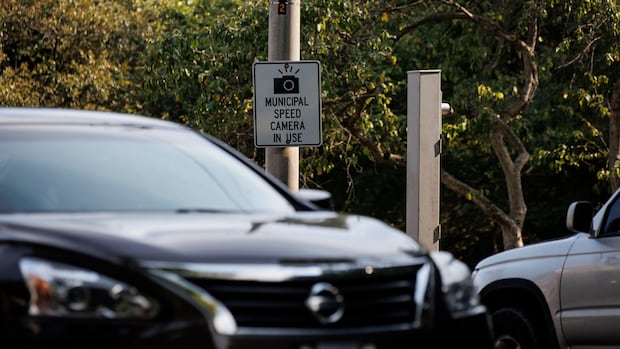Kitchener-WaterlooBill 56 is more than a repeal of speed cameras. It’s a wide-ranging legislative package designed, among other things, to streamline permit approvals and expand labour and health-care worker mobility. But experts say it also raises questions about public safety, environmental oversight and local control.Bill aims to make it easier to work in Ontario, get permit approvalsCameron Mahler · CBC News · Posted: Oct 26, 2025 6:00 AM EDT | Last Updated: 2 hours agoListen to this articleEstimated 5 minutesThe province has introduced Bill 56, which contains changes to the Highway Traffic Act to ban speed enforcement cameras. But that’s not all that’s in the omnibus bill. (Evan Mitsui/CBC)Ontario’s Bill 56, called the Building a More Competitive Economy Act, was tabled on Monday and it does more than just ban automated speed cameras.It’s an omnibus bill that amends more than a dozen laws — from environmental protections to health-care licensing and labour mobility — all with the aim of making Ontario “the most competitive place in the G7 to invest, create jobs and do business,” according to the provincial government.In total, Bill 56 presents 11 initiatives. Some of the key amendments include:Changes to environmental laws and regulations: Updates to the Clean Water Act, Species Conservation Act and Crown Forest Sustainability Act that aim to quicken permit approvals for big projects.Health and Labour: Allows for some health care and labour professions to practice and work in Ontario, so long as they’re certified in other provinces.Highway Traffic Act: Repeals automated speed enforcement and centralizes authority over school zone signage.Environmental amendmentsJulie Simmons is an associate professor in the political sciences department at the University of Guelph. She said streamlining permit approvals should increase the speed at which projects get approved.When it comes to some large projects like housing starts, manufacturing development, major natural resource extraction projects and highway development, Simmons says it’s typical for multiple ministries to need to sign off on their own regulatory requirements. This bill changes that to a “one-window approach,” where multiple hands in the pot turn into one centralized channel.Julie Simmons is an associate professor of political science at the University of Guelph. She says Ontario’s Bill 56 reflects the government’s narrative of economic crisis. (Julie Simmons)But Simmons says some of the processes this bill would remove were put in place “to protect things like the environment, to protect things like Indigenous understandings of land use.”She said where individual permit approvals may come with consultation and environmental review requirements, the “smaller issues that might have arisen on a permit-by-permit basis won’t necessarily get that same airing and deliberation.”Simmons said, if implemented as described, the bill should accomplish the government’s economic-growth intentions.“If the streamlining goes ahead as the government has written it, then it is certainly going to eliminate some of the activities that … may have the unintended consequence of slowing down economic development,” she said.Amendments to healthcare and labour worker mobilityA major amendment in Bill 56 is to the Regulated Health Professions Act, 1991. It now allows for some specific health care professions that have received certification in other provinces to practice in Ontario, without any additional requirements. Specifically mentioned in the bill are audiology, dental technology, dentistry and denturism professions.Similarly, amendments to the Ontario Labour Mobility Act, 2009, would allow for workers in other provinces that are “deemed to be certified” in a trade that is regulated in Ontario to work in this province, too.The bill does not list which regulated trades are included under the new labour mobility rules.WATCH | Premier Doug Ford says he’ll ban speed cameras:Ford says he will ban ‘cash grab’ speed camerasOntario Premier Doug Ford called speed cameras an ineffective ‘tax grab’ and announced his government will soon table legislation to ban their use despite findings from police associations and municipalities backing the effectiveness of the cameras.Amendments to Highway Traffic Act: Speed camerasOne of the most debated elements of Bill 56 is the elimination of automated speed cameras in school zones, previously allowed under the Highway Traffic Act.Instead, the provincial government will instruct municipalities to install adequate school-zone signage — and will install it themselves if municipalities don’t comply.Carrie Mitchell is the founder of Speed Cameras Save Lives and an associate professor in the School of Planning at the University of Waterloo.She said her fight to protect automated speed cameras comes from having a six-year-old-daughter and living on a busy residential street where people tend to go too fast.“I don’t feel comfortable letting her walk on our city streets,” she said. “These speed cameras are an evidence-based tool … to slow folks down.”Carrie Mitchell says she’s concerned about speeding in her London, Ont., neighbourhood. The University of Waterloo associate professor started a campaign called Speed Cameras Save Lives to try to convince the province not to ban the speed enforcement cameras. (Kendra Seguin/CBC)She said the 28 school zones in Waterloo region that have the cameras reported average vehicle speeds reducing by 15 km/h after just a couple months.“If you hit somebody going 50 km/h, they have a very low chance of survival. So that 15 km makes a really big difference, especially for children.”Premier Doug Ford has called the cameras a “cash grab,” presenting Bill 56’s change as a relief to drivers. But Mitchell says his decision “makes for really great political theatre.”“The devil’s in the details in bills like Bill 56,” she said. “What I’m seeing is a pattern of moving control away from municipalities and moving power to Queen’s Park, in the hands of a few ministers.”Simmons agrees, saying she believes the addition of the automated speed camera ban to an economic growth bill was a political decision “that certainly resonates with that sort of populous impulse that the government has.”Overall, Simmons said the bill reflects what she called a government narrative of economic crisis.But she says these amendments aren’t new. Instead she believes this bill is “putting in place actions and objectives of the [Progressive] Conservative party that pre-date that narrative of crisis.”CBC News requested an interview with the Minister of Red Tape Reduction, Andrea Khanjin, who presented Bill 56 to the Ontario Legislature, but did not receive a response before publication.Bill 56 is now awaiting a third reading at Queen’s Park.ABOUT THE AUTHORCameron is a journalist with CBC News. He’s worked with CBC Kitchener-Waterloo covering local news, municipal councils, and both the 2025 provincial and federal elections. Cameron also interned with CBC Toronto’s Enterprise Unit, helping to cover elements of the Greenbelt controversy. Contact Cameron with story ideas at cameron.mahler@cbc.ca. Follow Cameron on X @cam_mahler
Wednesday, 17 Dec 2025
Canada – The Illusion
Search
Have an existing account?
Sign In
© 2022 Foxiz News Network. Ruby Design Company. All Rights Reserved.
You May also Like
- More News:
- history
- Standing Bear Network
- John Gonzalez
- ᐊᔭᐦᑊ ayahp — It happened
- Creation
- Beneath the Water
- Olympic gold medal
- Jim Thorpe
- type O blood
- the bringer of life
- Raven
- Wás’agi
- NoiseCat
- 'Sugarcane'
- The rivers still sing
- ᑲᓂᐸᐏᐟ ᒪᐢᑿ
- ᐅᑳᐤ okâw — We remember
- ᐊᓂᓈᐯᐃᐧᐣ aninâpêwin — Truth
- This is what it means to be human.
- Nokoma











